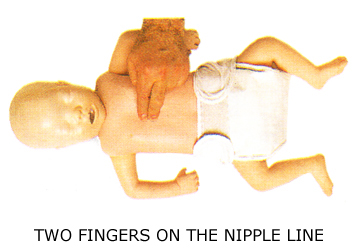Infant Compressions
PERFORMING CPR
Studies of out-of-hospital adult cardiac arrest incidents have shown that survival rate was significantly higher whenever bystanders attempted to administer CPR with emphasis on blood flow and not solely on the precise sequence of compressions and rescue breaths. In other words, rather than not attempt CPR for fear of doing it incorrectly, it is more important to circulate oxygenated blood by pushing fast than to remember how many times to push.
Before commencing CPR you must first check the victim for pulse. Unlike with an adult or child, an infant’s pulse is checked at the brachial artery which is located inside of the upper arm, between the elbow and the shoulder. Locate the artery and place two fingers on it, applying slight pressure for 5 to 10 seconds. If unsure or you definitely do not feel a pulse within that timeframe, it’s best to immediately begin chest compressions.
“C” is for COMPRESSIONS 
An infant’s delicate ribcage is especially susceptible to damage if chest compressions are improperly performed, therefore it is important to use caution when rescuing an infant. With the infant victim flat on his back, place two fingers in the center of his chest at or just below the nipple line. The compression should be approximately one-third (1/3) to one-half (1/2) the depth of the chest. A good way to remember this is half-hand, half-chest deep.